This week’s blog contains several items of good news, somewhat in contrast to the national situation. Firstly, it gives me great pleasure to record that Tracey Dessoy and Jane Richardson have been awarded grants from the Ian Coulson Postgraduate Award fund.
As regular readers of the blog will know, Jane is working on the foundation, development and dissolution of the three Kentish monastic houses dissolved by Cardinal Wolsey as he looked for ways to finance his university college and school. Ok, I know Bayham has a foot in Sussex as well as Kent, but the other two: Tonbridge Priory and Lesnes Abbey are securely in historic Kent. For her doctorate, thus far Jane has concentrated on Tonbridge Priory, but when she is able to get back into the county archives at Maidstone, she will be broadening this out much further to bring in the other two houses, not least through bequests in the testamentary records of the Rochester diocese.
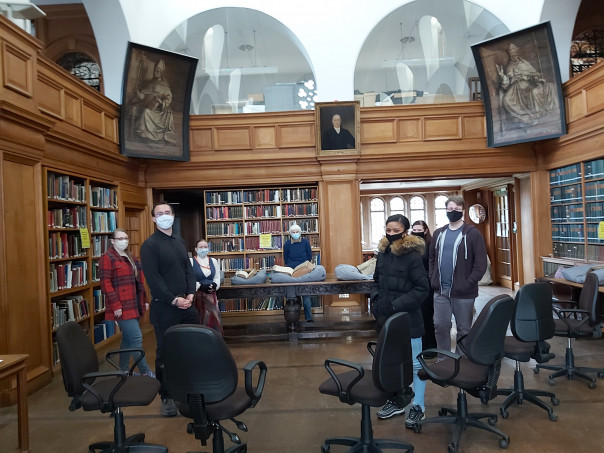
Tracey’s project focuses on east Kent, specifically Canterbury and its hinterland, and again as regular readers will know, she is working on the knightly families, especially the female members from the high to the later Middle Ages. She, too, needs to get back into the archives, although initially that is at Canterbury Cathedral, although she has been making good use lately of the increasing number of online documents, in her case those from St Augustine’s Abbey, including Thorne’s Chronicle in its Latin manuscript. She is also drawing on archaeology because she is seeking to identify the manorial centres and the associated chapels which would have been used primarily by the knightly family and probably the extended household.
Secondly, for later readers of last week’s blog, I added a photo of the responses from the audience at the celebratory internship event regarding the Centre’s project about the parish and people of St Mildred’s church, Canterbury, in the medieval period. The intern in question was Bethany Brown who did an excellent job producing text for the pop-up banners and leaflet. I have featured some of these before, but as far as I can see I haven’t previously mentioned her banner on ‘The Life of the Church’ that features amongst other things the Easter Sepulchre at St Mildred’s to which Roger Rydle gave £2 (about £1,371 in today’s money) in 1472.
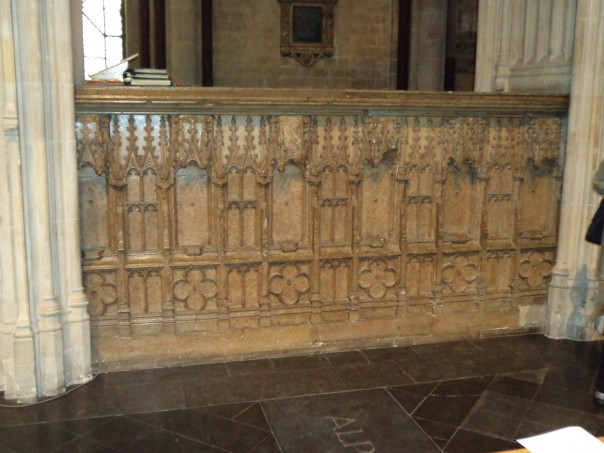
Located to the north of the high altar, the Easter Sepulchre was a box or similar often highly decorated receptacle into which the consecrated host was placed on Good Friday where it would be watched over until Easter Sunday when it would be taken out and Mass celebrated. For those keeping watch, the churchwardens’ provided refreshments, such as the 9d covering two years expenses on bread and drink by the St Dunstan’s churchwardens’ in 1524. If you are in Canterbury and want to see such an ‘Easter sepulchre’ in situ, do visit Archbishop Bourchier’s funeral monument in the cathedral because table-top tombs were used in this way.
Thirdly, the ‘Maritime Kent through the Ages’ manuscript went off to Boydell on Sunday evening, which was a great relief. Having 23 chapters, including an Afterword by Margarette Lincoln who has published extensively on maritime history and was until 2015 the Deputy Director of the National Maritime Museum, Greenwich, it is going to be a weighty tome in more ways than one. As editors, Dr Elizabeth Edwards, Stuart Bligh and I are delighted at the way it has come together, and, as Margarette says “The wide-ranging essays in this volume … demonstrate that the maritime history of Kent is a dynamic focus of discussion illuminating modern developments.” And that the “volume neatly demonstrates how different disciplines – history, archaeology, geography, literary studies – can complement each other to illuminate a subject, not least because maritime history supports many perspectives.”
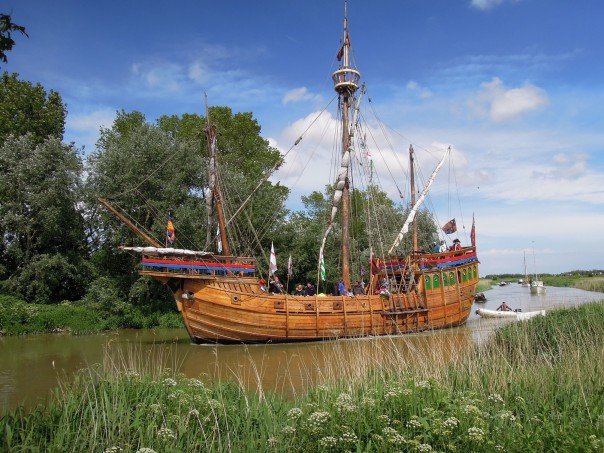
Moreover, by drawing together the references from all the chapters, the extensive bibliography will provide a valuable resource for those interested in maritime history throughout the centuries. As things progress, I’ll keep you informed and all being well we are hoping for publication next year with a joint conference between the Centre and Kent Archaeological Society in the autumn – hopefully physically in Canterbury but if not then online – to complement the conference that kickstarted the project in June 2018. For that will also be a good way to thank KAS as the principal sponsor. Additionally, it is great to note that among the contributors there are several from the three universities in Kent, thereby demonstrating the rich scholarly culture in the county, as well as international contributors: Professor Maryanne Kowaleski, a world-renowned expert on medieval maritime history, from Fordham University, New York.
Fourthly, Dr Diane Heath and I took the Medieval & Early Modern Studies 1st year undergraduate group to Canterbury Cathedral Archives this week (Dr Leonie Hicks had previously taken the 2nd year MEMS group). This was the first time that I had set foot in the archives since ‘lockdown’ and it was great to be welcomed back by Cressida Williams, the Archive Manager, and Daniel Korachi-Alaoui, Archives Assistant. Among the treasures we looked at were Canterbury City’s chamberlains’ accounts from the late 14th century and copies of wills in another civic book from the same period – when Richard II was a boy king and the Peasants’ Revolt was fresh in people’s minds. Diane provided the students with insights concerning Books of Hours, as well as early modern Bibles: Henry VIII’s ‘Great Bible’ and the Calvinist ‘Geneva Bible’.
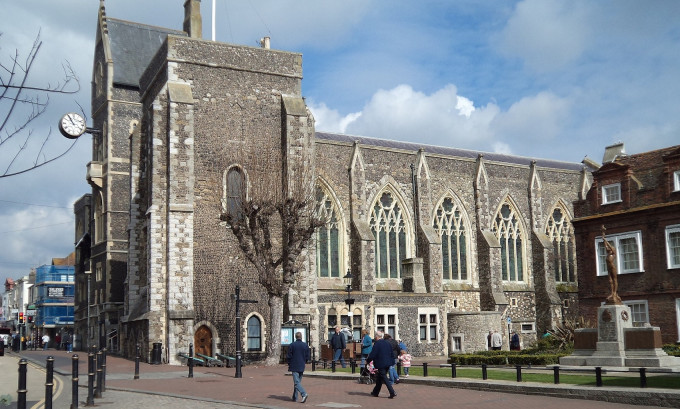
Fifthly, having worked in the past on the records of Dover’s Maison Dieu hospital and visited the place in the company of Rupert Austin (Canterbury Archaeological Trust) when he was assessing the building’s medieval structure, I have more good news. Jon Iveson from Dover Museum (who spoke at the Maritime Kent conference in 2018) has been heavily involved in a grant application to the National Heritage Lottery, and it can now be revealed that this has been successful, which means the Fund have recently confirmed a £4.27m grant to deliver the Maison Dieu project: ‘Reawakening a Neo-Gothic Masterpiece as Dover’s Maison Dieu’.
One of the beauties of this building and the project to give it a new life, is that it was important in the Middle Ages – as a hospital for pilgrims under royal patronage; in the early modern period – as a naval victualling store; and in modern times – as a very rare example of William Burges’ civic work and an important landmark in the Gothic revival style, comprising civic offices, court room and gaol, as well as a concert hall. Thus, once complete in 2023, the Maison Dieu will be permanently open to the public for the first time in its 800-year history and contributing to the creation of a heritage quarter in Dover town centre, thereby giving the town a much needed boost and providing an exciting prospect for a whole host of reasons. Again, I’ll report back as things progress.
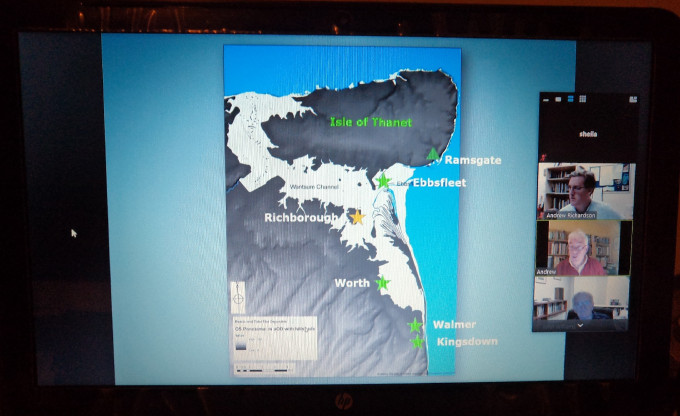
Finally, it is great to report that the Friends of Canterbury Archaeological Trust’s first online lecture at the end of last week was a success. Because the Friends have provided Zoom for CAT, this was the platform used, capably organised by Dr Andrew Richardson, the Trust’s Outreach & Archives Manager, and incidentally another contributor to Maritime Kent, while Dr John Williams, the Chairman of FCAT, introduced the speaker.
Professor Andrew Fitzpatrick (University of Leicester) gave a fascinating talk on Julius Caesar’s two expeditions to Britain in 55 and 54 BC, seeing them in the light of Caesar’s military campaigns in Gaul and the intense rivalry for fame among Caesar, Crassus and Pompey. Furthermore, rather than viewing these expeditions as failures, Andrew believes they should be seen as successful campaigns because they achieved Caesar’s goals, and were not meant to be an invasion of Britain.
Having set out the political background concerning Rome’s attitude to the known world and how its generals operated to achieve renown, status and wealth, Andrew turned to what can be deduced regarding how these expeditions were conducted, using Caesar’s own accounts and the archaeological evidence. He first became interested in this when he was working for Wessex Archaeology in Thanet, and one of the aspects that he discussed in some detail was Caesar’s landing place, especially for the second expedition. He believes this occurred at Pegwell Bay/Ebbsfleet not only from Caesar’s description of seeing cliffs nearby and landing on a soft, open beach, but also because of the large defensive feature found there, which he sees as having a strong parallel to one in Gaul from the same period.
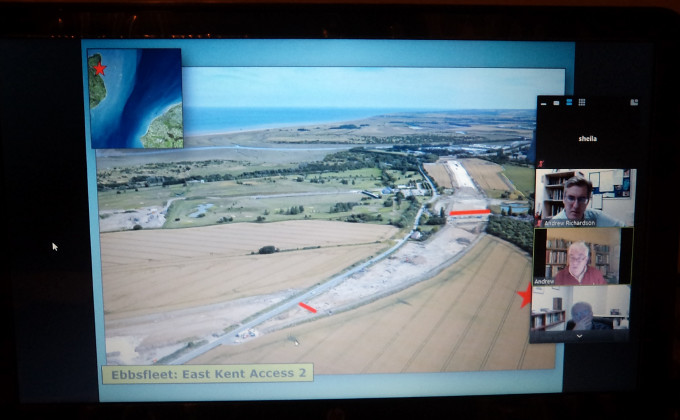
From this bridgehead, Andrew went on to discuss what Caesar did next, including the two battles close to Canterbury, the first he believes took place on the southern approach to Bigbury to the west of the city. He expanded his account to explore Caesar’s next moves, including a battle in Essex, the defeat of the Britons, the taking of hostages and the extracting of tribute.
The final section of his lecture comprised ideas about Caesar’s Triumph, what it may have comprised, including a golden statue to represent Caesar as conqueror of the sea that may have involved Neptune, the parading of the British hostages and the use of chariots to convey the conquering hero. As a result, Caesar was able to establish his pre-eminence and upstage Pompey by recasting the Roman world map because his exploits had taken him to the very edge and beyond.
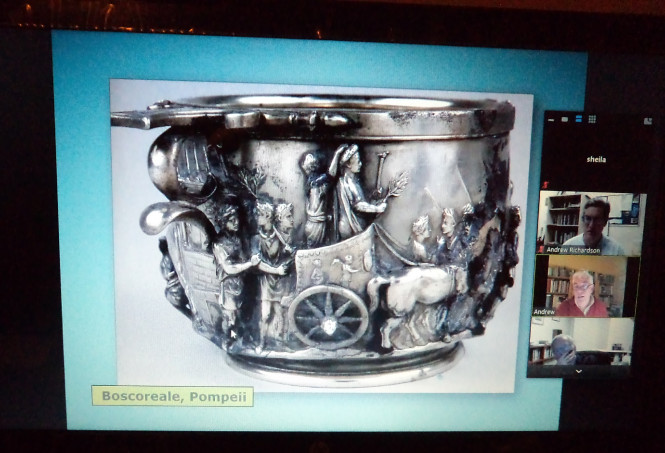
John Williams thanked Andrew for such an interesting and enlightening lecture, and after a slight hesitation as people among the 68-strong audience got used to the technology, a stream of questions started to come in via the ‘chat’. Once these had finished, John thanked both Andrews before drawing the meeting to a close with a reminder that next month the talk will be given by Dr Jake Weekes of the Trust who will be speaking on the new Historic Map of Canterbury.
 Centre for Kent History and Heritage
Centre for Kent History and Heritage Sheila Sweetinburgh
Sheila Sweetinburgh 1557
1557

